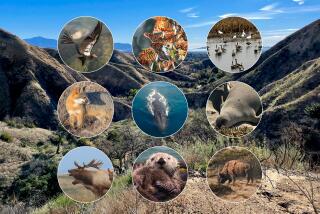Birders atwitter over sighting at Salton Sea
Guy McCaskie had only a couple of hours of light left when he arrived at Salton Sea after a day of birding in Imperial County. As coauthor of “Birds of Salton Sea,” he knew the area well, knew it was a place where surprising birds sometimes turned up.
Still, when he glanced out the window of his car while approaching the Red Hill Marina near Calipatria in Imperial County last Friday, he couldn’t quite believe what he was seeing. It looked like a Ross’s gull.
Salton Sea, the largest inland body of water on the Pacific flyway, is a stopping point for all kinds of migrating birds heading south for the winter.
But a Ross’s gull?
The smallish, white gull is an arctic species, breeding primarily in Siberia or Greenland. In winter it sometimes gets to northern Alaska, and every few years one shows up in the northern part of the lower 48 states, usually on the northeast coast.
A Ross’s gull at Salton Sea would put the bird hundreds of miles farther south than it had been reported anywhere in the world.
McCaskie jumped from his car and trained his binoculars on the bird. He’d seen Ross’s gulls several times before, twice in northwest Alaska and once in the far north of Canada. And he’d seen hundreds of pictures of the bird. This could be nothing else.
“It was a really fancy bird,” he said.
McCaskie had spotted what birders call a “mega-rarity.”
In the Internet era of instant reporting, the bird’s appearance at Salton Sea would be certain to trigger a rush of birders who would race to the remote outpost for what might be a once-in-a-lifetime look at the bird.
When birders spot something remarkable, their first concern is documenting the sighting. This would be the first record of a Ross’s gull in California, and McCaskie wanted it to be uncontestable.
He used his cellphone to call several local birders he knew and urged them to drop everything and come with cameras to see the gull.
A birder as respected as McCaskie would have been believed even if no one else saw the bird. But with something that rare, he wanted witnesses.
Half an hour after the phone call, he got them. In a posting at 8:30 that night on Calbirds, an Internet message board for California birders, McCaskie described the scene: “Bob Miller and Kenneth Z. Kurland both arrived before dark, and photographs were obtained. Terry Hunefeld arrived after dark, but was able to see the bird with the aid of my headlights.”
But even before McCaskie was able to post details of his sighting, birders from all over the state were racing to Salton Sea.
Scott Terrill got the news about 4 p.m. His son, who was attending a birding conference in the Central Valley, had heard about the sighting and called to tell his father. Minutes later, a co-worker came in to report news of an Internet posting of the bird. And just after that, a birding friend in Southern California gave him a call. The frenzy had begun.
Like many birders, Terrill, an ornithologist with a San Francisco Bay Area environmental consulting firm, keeps lists of the birds he’s seen. Lists are kept by state, by region, by time of year. A Ross’s gull was a great sighting for any list. For a California list, it was a crown jewel. The bird had never before been seen in the state.
Terrill quickly called his wife, who agreed that they should make the trek from the Bay Area to Salton Sea. After work that night, they headed south.
“We thought it was worth a 10-hour drive, even knowing we might not see the bird,” he said. “It’s a really good bird.”
At 4:30 the next morning, Terrill and his wife joined a growing number of cars at the Red Hill Marina. By a little after 5:30, with barely enough light to see, about 40 people had gathered with high-powered telescopes, long-lens cameras and binoculars pointed at the spot on the mud flats where the bird had last been seen. Soon, a few stragglers looking in another part of the marina spotted the bird.
Over the course of the day, Terrill estimated, the crowd swelled to 150. The gull was surprisingly cooperative. “It spent most of the day foraging in the mud flats for small invertebrates,” Terrill said.
That night, Bob Miller of Brawley posted an exuberant message on Calbirds: “A day to remember?! For sure!! I believe the bird was seen by everyone that came for it today with the exception of the last birder to arrive before sunset.”
Birders who arrived the next day weren’t as lucky. Those present at dawn saw the bird, but about 6:30 it flew off, leaving dozens of disappointed birders who arrived later.
McCaskie is happy to have seen the “fancy” gull. But he said he doesn’t bird simply for the rarities. He keeps records of when he sees which kind of bird, documenting the movements of various species in an attempt to better understand them. Even common birds are interesting to him if they’re behaving unusually.
“If I find a bird that’s one day earlier than my earliest record of it, that’s exciting,” he said.
More to Read
Sign up for Essential California
The most important California stories and recommendations in your inbox every morning.
You may occasionally receive promotional content from the Los Angeles Times.











